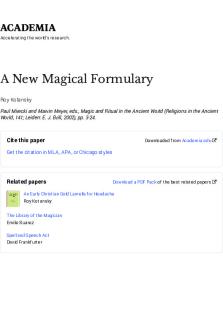Direct New SAS Output to a New Results File PDF

| Title | Direct New SAS Output to a New Results File |
|---|---|
| Course | Multivariate Statistical Analysis |
| Institution | East Carolina University |
| Pages | 5 |
| File Size | 415.8 KB |
| File Type | |
| Total Downloads | 32 |
| Total Views | 128 |
Summary
Direct New SAS Output to a New Results File...
Description
Direct New SAS Output to a New Results File SAS 9.3 creates, by default, an htm file with your results. It does look a lot better than the old plain text listings. However, you cannot “Edit, Clear All” like you can with listing output. All of the output from the current session is put into one file. This is very annoying if you, like me, fiddle around for a while until you get the code right for producing the output you wish to save.
As you can see here, the “Clear” option is grayed out.
Update, August, 2013: The version of SAS 9.3 installed into our labs this month does include “Edit, Clear All” functionality. Update, August, 2014. The version of SAS 9.3 installed into Rawl 135 this month does NOT include “Edit, Clear All” functionality, but the version of SAS 9.4 does. You can, however, close the current output file and start a new one by issuing these commands: “ods html close; ods html;” . You could just execute NewViewer.sas every time you wish to start a new viewer, but it is more convenient to create a new tool to do this. Here is how to do so:
Click on the “Add tool” icon.
Enter the text shown above. gsubmit "ods html close; ods html;"
Click OK
Click Yes. Then go back to the Customize Tools window.
Click on the “Change icon” icon.
Select the icon you desire and then OK, OK, Yes.
You will now see that icon in the Results Viewer toolbar and can simply click on it every time you wish to direct new output to a new output file.
If you have been using Proc Reg or Proc GLM, SAS may refuse to clear the results window, giving you an error message like this: “Proc GLM is currently executing, blah, blah, blah.” The problem is that a few SAS procedures, like GLM and Reg, are interactive in the sense they are not terminated by the run command. To avoid this problem, when using GLM or Reg, always follow the GLM or Reg commands with a “run;” command and a “quit;” command. Karl L. Wuensch, September, 2013. Return to Karl’s SAS Lessons Page...
Similar Free PDFs

NEW 2 - NEW 2
- 4 Pages

New-501 - new
- 12 Pages

A New Magical Formulary
- 490 Pages

A New England Nun
- 2 Pages

Develop a new food product
- 20 Pages
Popular Institutions
- Tinajero National High School - Annex
- Politeknik Caltex Riau
- Yokohama City University
- SGT University
- University of Al-Qadisiyah
- Divine Word College of Vigan
- Techniek College Rotterdam
- Universidade de Santiago
- Universiti Teknologi MARA Cawangan Johor Kampus Pasir Gudang
- Poltekkes Kemenkes Yogyakarta
- Baguio City National High School
- Colegio san marcos
- preparatoria uno
- Centro de Bachillerato Tecnológico Industrial y de Servicios No. 107
- Dalian Maritime University
- Quang Trung Secondary School
- Colegio Tecnológico en Informática
- Corporación Regional de Educación Superior
- Grupo CEDVA
- Dar Al Uloom University
- Centro de Estudios Preuniversitarios de la Universidad Nacional de Ingeniería
- 上智大学
- Aakash International School, Nuna Majara
- San Felipe Neri Catholic School
- Kang Chiao International School - New Taipei City
- Misamis Occidental National High School
- Institución Educativa Escuela Normal Juan Ladrilleros
- Kolehiyo ng Pantukan
- Batanes State College
- Instituto Continental
- Sekolah Menengah Kejuruan Kesehatan Kaltara (Tarakan)
- Colegio de La Inmaculada Concepcion - Cebu










